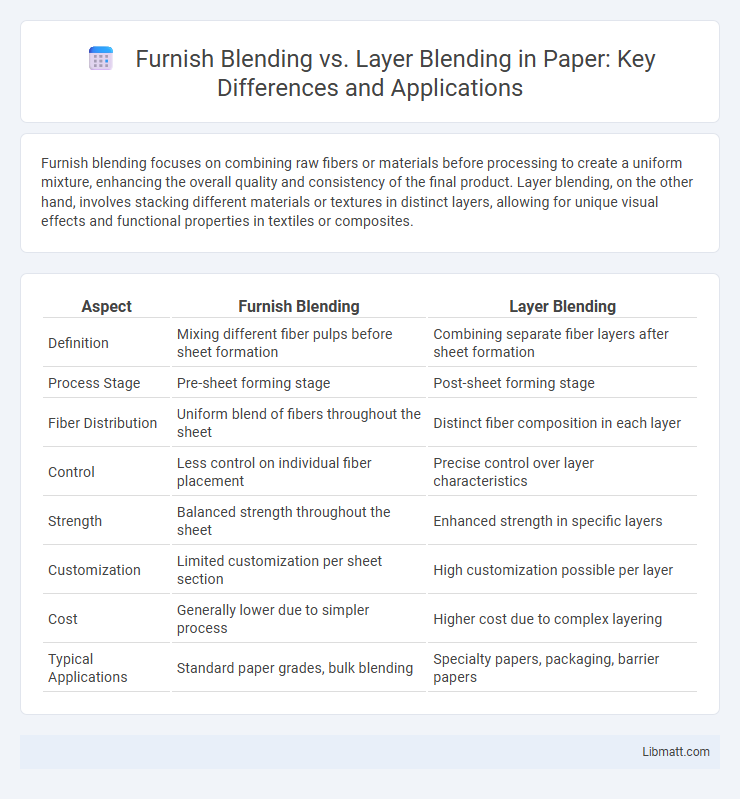Furnish blending focuses on combining raw fibers or materials before processing to create a uniform mixture, enhancing the overall quality and consistency of the final product. Layer blending, on the other hand, involves stacking different materials or textures in distinct layers, allowing for unique visual effects and functional properties in textiles or composites.
Table of Comparison
| Aspect | Furnish Blending | Layer Blending |
|---|---|---|
| Definition | Mixing different fiber pulps before sheet formation | Combining separate fiber layers after sheet formation |
| Process Stage | Pre-sheet forming stage | Post-sheet forming stage |
| Fiber Distribution | Uniform blend of fibers throughout the sheet | Distinct fiber composition in each layer |
| Control | Less control on individual fiber placement | Precise control over layer characteristics |
| Strength | Balanced strength throughout the sheet | Enhanced strength in specific layers |
| Customization | Limited customization per sheet section | High customization possible per layer |
| Cost | Generally lower due to simpler process | Higher cost due to complex layering |
| Typical Applications | Standard paper grades, bulk blending | Specialty papers, packaging, barrier papers |
Introduction to Blending in Interior Design
Blending in interior design enhances visual harmony by combining textures, colors, and materials to create cohesive spaces. Furnish blending specifically refers to integrating furniture styles and finishes to balance function and aesthetics, while layer blending involves stacking elements like rugs, cushions, and artwork to add depth and dimension. Understanding these blending techniques helps you achieve a seamless, personalized interior that reflects your style and comfort preferences.
Defining Furnish Blending
Furnish blending refers to the process of combining different pulp fibers before sheet formation to achieve desired paper quality by adjusting fiber characteristics such as length, strength, and fines content. This method ensures a uniform fiber mixture, enhancing properties like tensile strength, opacity, and smoothness in the final product. In contrast, layer blending involves stacking distinct fiber layers, allowing controlled variation in paper properties through separate fiber composition in each layer.
Understanding Layer Blending
Layer blending determines how two image layers interact by modifying pixel values based on blending modes like Multiply, Screen, or Overlay, which affect contrast, brightness, and color dynamics. Furnish blending, a specialized technique, enhances textures and surface details by selectively combining material properties such as diffuse and specular layers for realism in 3D renders. Understanding layer blending enables precise control over visual effects and texture integration, crucial for achieving lifelike digital imagery.
Key Differences: Furnish vs Layer Blending
Furnish blending involves combining raw materials, such as fibers in papermaking, before the manufacturing process, optimizing the uniformity and overall quality of the product. Layer blending refers to stacking multiple layers of materials or images, each with distinct properties, to create composite outputs with enhanced texture or visual effects. Key differences lie in their application timing--furnish blending occurs pre-production for material consistency, while layer blending is a post-production technique aimed at improving surface characteristics or design complexity.
Aesthetic Impact of Each Technique
Furnish blending creates a more unified and natural aesthetic by seamlessly merging textures, colors, and materials, resulting in a cohesive visual appearance that enhances spatial harmony. Layer blending offers distinct control over individual elements, allowing for dramatic contrasts and bold visual effects that emphasize depth and dimension in your design. Both techniques uniquely influence the overall mood and visual impact, with furnish blending favoring subtle integration and layer blending enabling pronounced artistic expression.
Practical Applications in Home Design
Furnish blending in home design involves combining different furniture styles, textures, and colors to create a cohesive, personalized living space that reflects your unique taste. Layer blending focuses on adding depth and visual interest by stacking materials, patterns, and elements like rugs, curtains, and cushions. Both techniques play a crucial role in achieving balanced aesthetics and functional comfort in your interior design projects.
Pros and Cons of Furnish Blending
Furnish blending enhances pulp quality by combining different fibers before sheet formation, resulting in better fiber distribution and improved paper strength. It offers cost efficiency through uniform raw material use but can lead to reduced control over individual layer properties compared to layer blending. However, furnish blending may limit the ability to optimize specialized functions such as printability or barrier properties that layer blending allows by applying distinct fiber compositions in separate layers.
Pros and Cons of Layer Blending
Layer blending offers precise control over the interaction of textures and materials, enabling more complex visual effects compared to furnish blending. The main advantage of layer blending lies in its ability to combine multiple texture layers with customizable opacity and blend modes, enhancing realism and detail in 3D models. Your challenge may include increased computational demands and potential complexity in managing layers, which can impact rendering performance and workflow efficiency.
Choosing the Right Blending Method
Furnish blending and layer blending are crucial techniques in digital design, where choosing the right blending method depends on the desired visual outcome and texture complexity. Furnish blending excels in creating smooth transitions by merging color and texture seamlessly, ideal for intricate patterns or fabric simulation. Layer blending, on the other hand, offers more control over opacity and interaction modes, making it suitable for compositing multiple images or effects with precise adjustments.
Expert Tips for Successful Blending
Expert tips for successful blending emphasize using Furnish blending to create smooth, consistent textures by adjusting base materials before layering. Layer blending focuses on combining separate textures with different blend modes for complex visual effects, ideal for detailed customization. You can enhance realism by carefully balancing opacity and blending modes to achieve seamless integration and depth in your designs.
Furnish blending vs layer blending Infographic

 libmatt.com
libmatt.com